
Neal
How Does Vibe Coding Compare to Low-Code Platforms
By Neal W.
TL;DR: Vibe coding uses AI to generate real code from natural language. Low-code uses drag-and-drop builders. Vibe coding gives you flexibility and ownership; low-code gives you structure and enterprise features. Use vibe coding for creative prototypes, low-code for scalable business tools.
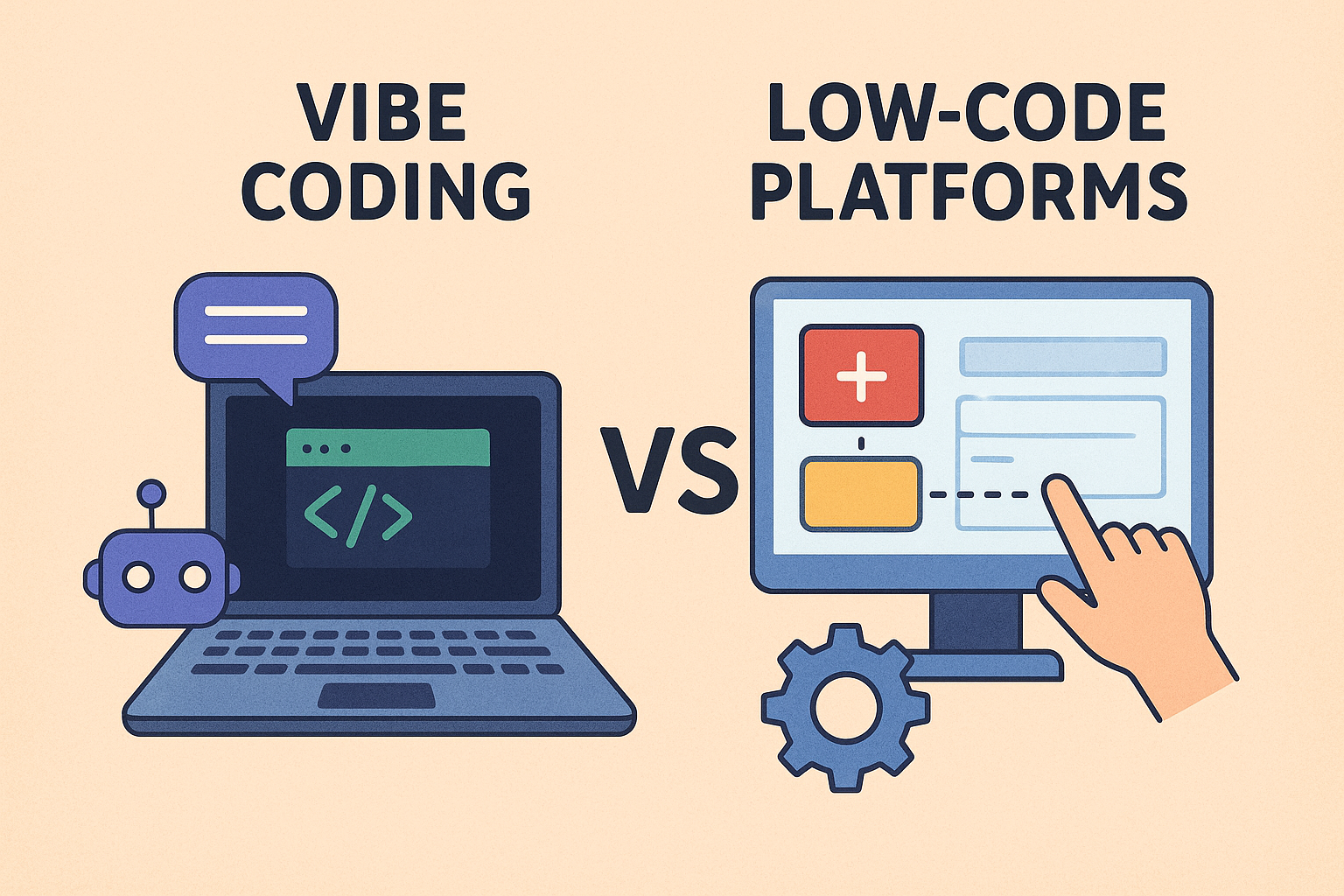
Images created by the author using ChatGPT.
How Does Vibe Coding Compare to Low-Code Platforms
App development is evolving fast. Low-code platforms let teams build software with minimal coding. Now, vibe coding is changing the game.
Both methods promise speed, accessibility, and creativity, but they serve different needs. Low-code is structured and enterprise-ready. Vibe coding is flexible, experimental, and powered by AI.
Let us explore how they differ, where each excels, and why the future of development might just blend both.
What Is Vibe Coding?
Definition:
Vibe coding is an AI-assisted development workflow that turns natural language prompts into real code. Instead of writing syntax or dragging elements, users describe what they want: “Build a dark-themed dashboard that shows user activity by region with interactive filters.”
In seconds, the AI generates functional code. You can then refine it, test it, and customize it further.
Popular tools include Cursor, Replit, Lovable, and v0.dev.
Vibe coding empowers both developers and non-developers to work faster, not by skipping the code, but by collaborating with AI to create it.
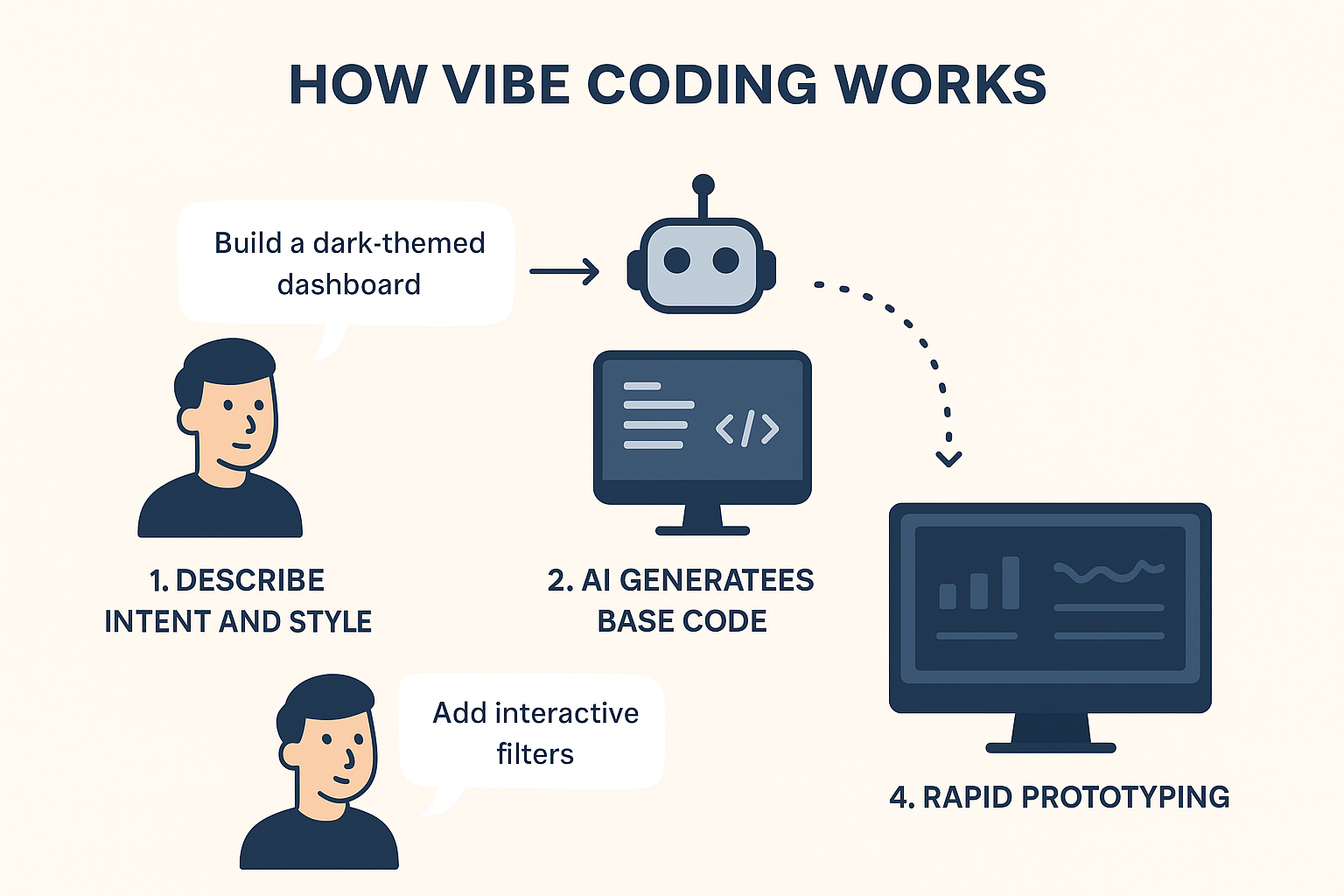
How Vibe Coding Works:
Vibe coding relies on large language models (LLMs) that understand natural language and translate it into frameworks like React, Next.js, or Tailwind CSS.
- You describe intent and style.
- The AI generates base code.
- You iterate by prompting adjustments (“add animations,” “make it responsive,” etc.).
The result: rapid prototyping with real, exportable code instead of a closed system.
What Are Low-Code Platforms?
Definition:
Low-code platforms are visual development tools that let users build apps using drag-and-drop interfaces, pre-built templates, and limited scripting.
You still write some code, typically for custom logic or integrations, but most of the work happens visually.
Popular tools include OutSystems, Mendix, Retool, and Microsoft Power Apps.
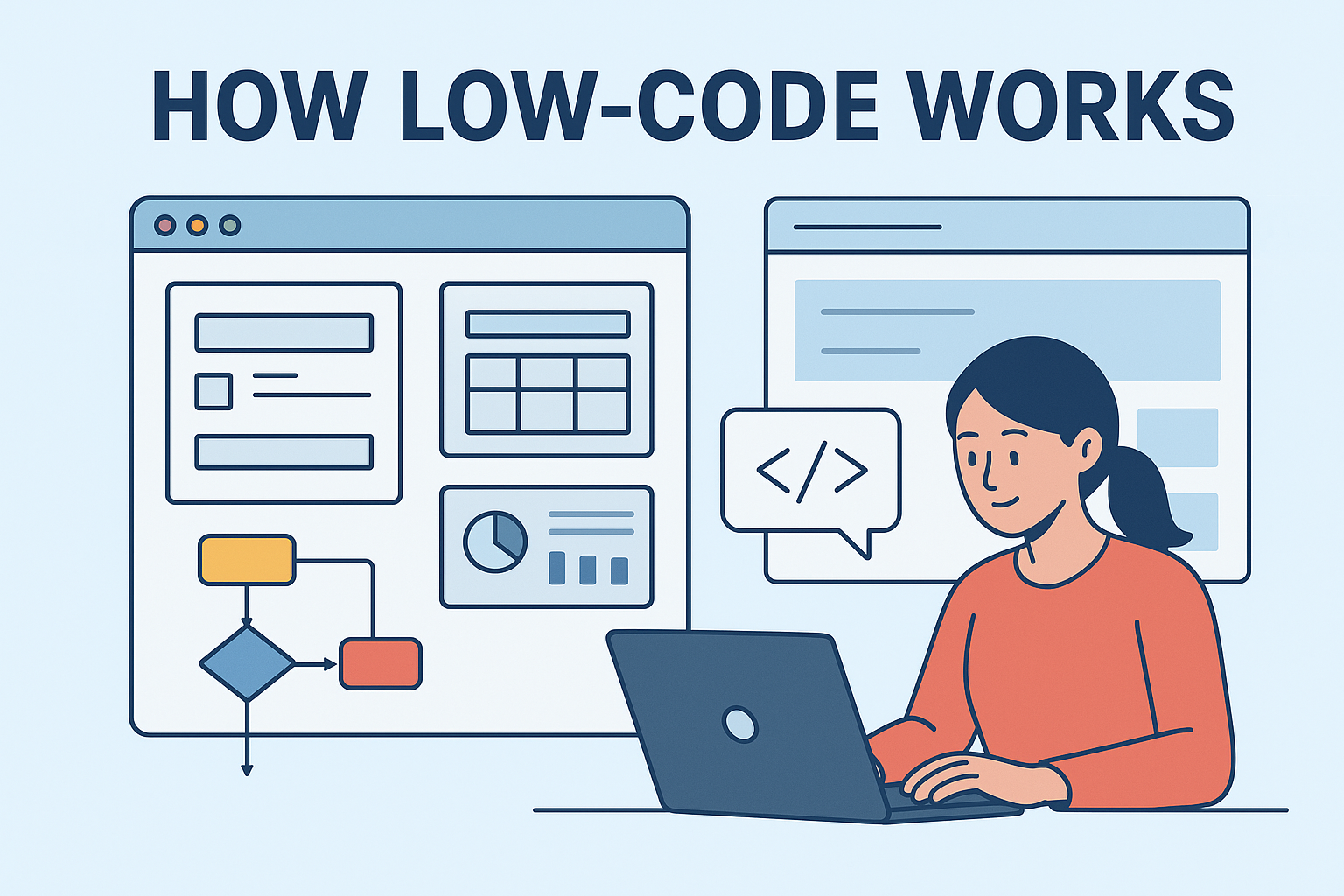
How Low-Code Works:
- Users create interfaces and workflows visually.
- Pre-built components (forms, tables, dashboards) are linked through simple logic rules.
- Advanced functionality can be added through scripting or APIs.
The platform handles hosting, deployment, and often compliance, which can be a major advantage for enterprise teams.
Core Differences Between Vibe Coding and Low-Code
The takeaway: vibe coding thrives on creativity and autonomy, while low-code excels in governance and scale.
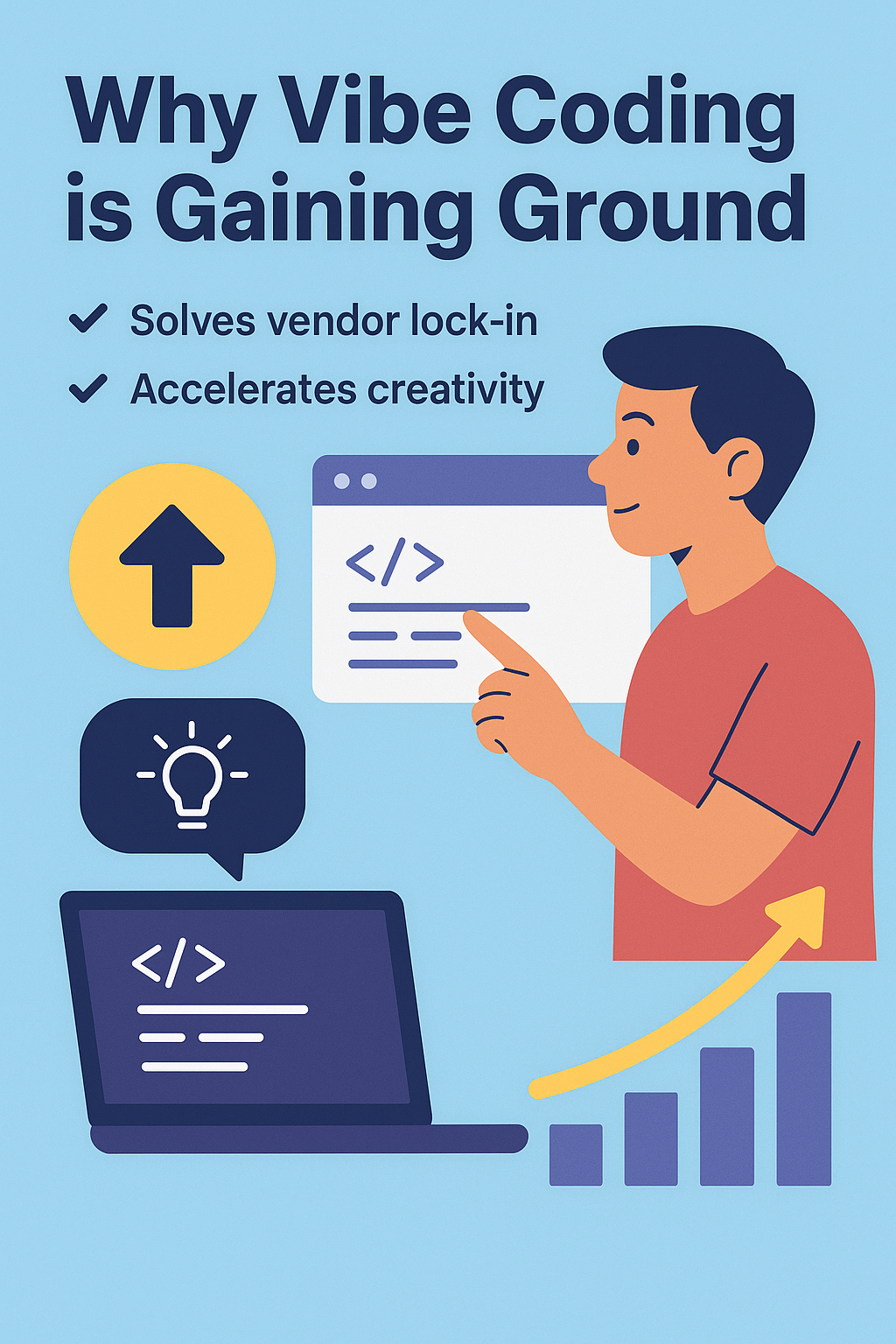
Why Vibe Coding Is Gaining Ground:
Developers and startups are gravitating toward vibe coding because it solves one of low-code’s long-standing frustrations: vendor lock-in.
With low-code, your code is often locked to the platform. With vibe coding, the AI writes standard code (HTML, CSS, JavaScript, Python) that you own and can deploy anywhere.
Vibe coding also accelerates creativity. Instead of building from menus and forms, you explore through conversation, and the AI handles the details, letting your imagination lead. You focus on design and flow, not syntax.
This fluidity is why developers, startups, and independent creators are paying attention.
Pros & Cons of Vibe Coding
Pros & Cons of Low Code
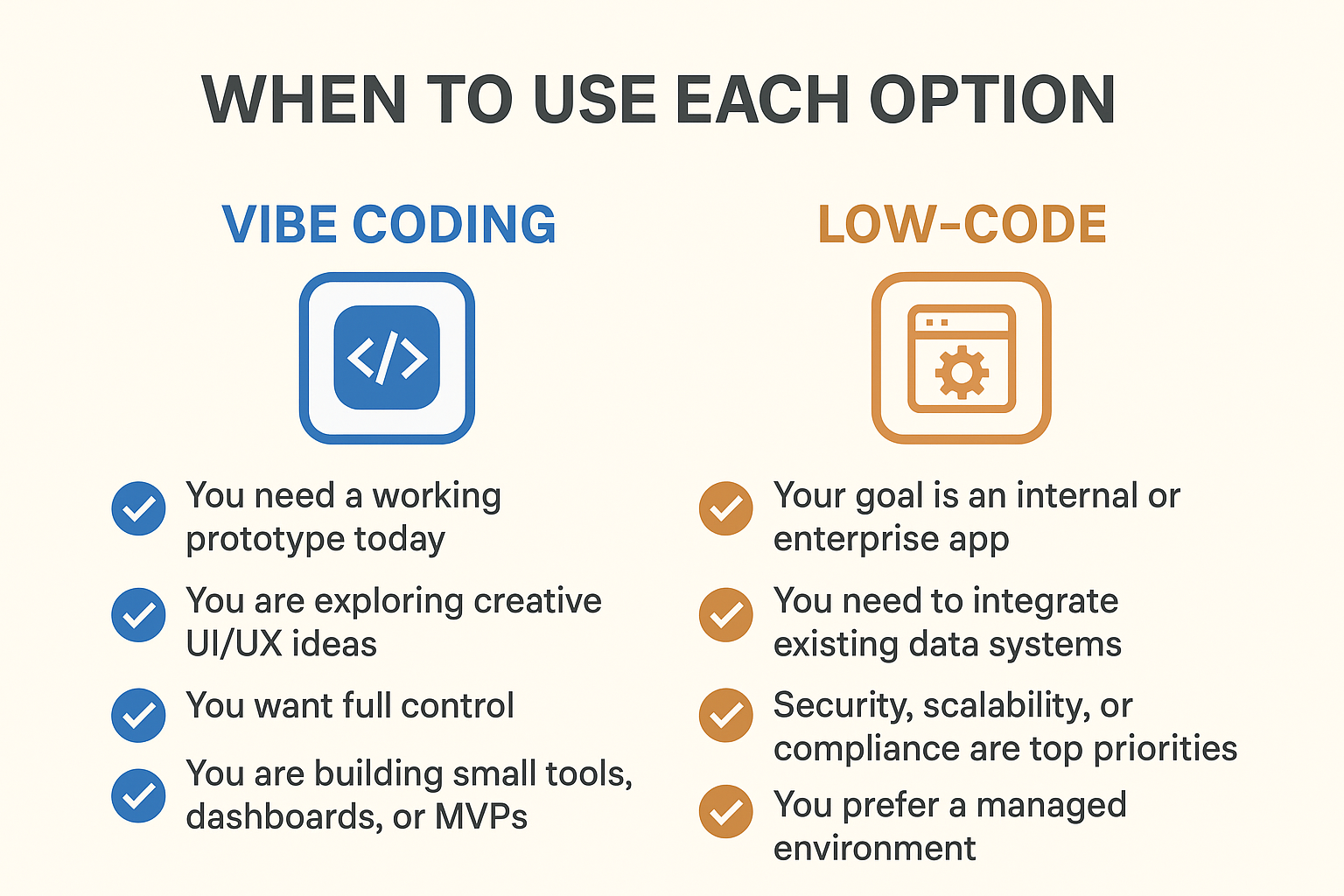
When to Use Each Approach
Use Vibe Coding When:
- You need a working prototype today.
- You are exploring creative or unique UI/UX ideas.
- You want to learn by observing real code and want full control.
- You are building small tools, dashboards, or MVPs.
Use Low-Code When:
- Your goal is an internal or enterprise app.
- You need to integrate existing data systems.
- Security, scalability, or compliance are top priorities.
- You prefer a managed environment with less maintenance.
Can Vibe and Low-Code Work Together?
Absolutely. In fact, many builders are already combining them. A common workflow using both (potentially) looks like this:
- Use vibe coding to rapidly generate and test an idea.
- Once validated, bring the concept into a low-code platform to scale, secure, and deploy it.
- Conversely, blending drag-and-drop features with vibe-coded elements is becoming popular for creators who need precise control over certain features but not others.
Meanwhile, low-code vendors (including Webflow) are now integrating AI copilots that suggest logic flows or generate components automatically. A signal that these two worlds are quickly merging.
The result: a hybrid future where natural language, visual building, and traditional coding converge into a seamless, intuitive experience.
Conclusion: The Balance Between Speed and Craft
Vibe coding and low-code are not rivals, but rather stages in a continuum of innovation.
- Low-code thrives on structure, governance, and scale.
- Vibe coding thrives on flexibility, experimentation, and speed.
Vibe coding is exciting because it reminds us why we build in the first place, to turn ideas into reality faster, easier, and more intuitively than ever before.
Just remember: embrace the vibe, but verify the code.
FAQs:
1. Is vibe coding replacing low-code?
No. Vibe coding complements low-code. Low-code focuses on structured business solutions, while vibe coding empowers creative experimentation and rapid development.
2. Can I use vibe coding for production apps?
Yes, but only with proper testing and review. Vibe coding excels for prototypes and early-stage builds. For production, combine it with human QA and best practices.
3. Do I need coding skills to use vibe coding?
No, but some technical curiosity helps. You don't need to write code by hand, but understanding basic logic, debugging, and web concepts will make you far more effective.
4. Which is faster: vibe coding or low-code?
For simple internal apps, low-code wins. For custom, creative builds, vibe coding often produces usable results faster.
5. What tools are best for each?
- Vibe Coding: Cursor, Replit, Lovable, Claude, v0.dev.
- Low-Code: Retool, OutSystems, Mendix, Appsmith, Power Apps.
6. Will AI replace developers?
No, AI coding tools are assistants, not replacements. They automate repetitive tasks but still depend on human expertise for architecture, testing, long-term maintenance and strategic decisions.
Over 200 free cloneable Webflow components. No sign up needed.
Add memberships to your React project in minutes.

.webp)







.png)